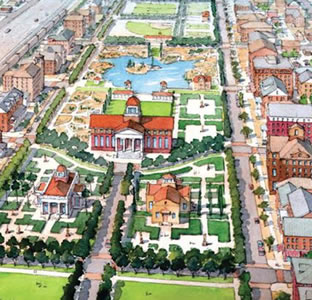UTSA hosts April 11 discussion on El Paso’s smart-growth plan

Artist’s rendering of Plan El Paso

Artist’s rendering of Plan El Paso
(April 10, 2013) -- The UTSA College of Architecture graduate program in urban and regional planning will present a discussion of Plan El Paso, the visionary, award-winning comprehensive plan that is guiding the Texas border city to a more sustainable future. Free and open to the public, the event will begin at 5:30 p.m., Thursday, April 11 in the Buena Vista Street Building Aula Canaria (1.328) on the UTSA Downtown Campus.
Mathew McElroy, director of the El Paso City Development Department, will speak on "How El Paso Developed America's Best Smart Growth Plan." Following the lecture, he will join El Paso County Judge Veronica Escobar and El Paso City Council Rep. Susie Byrd for a panel discussion moderated by City of San Antonio Planning and Community Development Director John Dugan.
The lecture is the final event in the UTSA College of Architecture Spring Lecture Series.
This event is sponsored by the Urban and Regional Planning Advisory Council and the UTSA Center for Urban and Regional Planning Research. It is presented in collaboration with American Planning Association San Antonio and the City of San Antonio Planning and Community Development Department.
As the nation's 19th-largest city with more than 750,000 residents, El Paso citizens were concerned about a variety of converging factors. Low-wage labor and land, historically the city's competitive advantages, had become far less valuable than creating a high quality of life that attracts and retains skilled labor on a national and international scale. Automobile-oriented development was isolating residents, while the upcoming expansion of nearby Fort Bliss created the need for thousands of housing units and increased infrastructure. The city initiated Plan El Paso in an effort to create more environmentally and socially sustainable communities, revitalize the urban core, protect historic neighborhoods and open space, improve public health, increase transportation options and stop urban sprawl.
The City of El Paso unanimously adopted Plan El Paso in March 2012, after two years of citywide meetings, workshops and discussions with citizens; lead consultants Dover, Kohl and Partners; stakeholders; community groups and national experts. Public engagement was the driving force behind the entire effort, which City Manager Joyce A. Wilson called "one of the most expansive planning processes in a generation," in a guest column for the El Paso Times.
A series of hands-on public design charrettes and planning workshops, which included more than eight weeks of intensive community exercises and policy discussions, helped generate the plan's bold vision. Since Spanish is the primary language of more than 70 percent of El Paso's residents, the city conducted bilingual outreach and a translator was present at most public events. An interactive project website received more than 30,000 visitors, sparking further discussion.
Reinforcing the pivotal role of constituents in this process was the final plan's introduction, which states, "Plan El Paso was created in El Paso and the best ideas came from El Pasoans. As a reward for undertaking this effort and persevering in its implementation, El Pasoans will one day remember themselves as the authors of the plan as well as the beneficiaries of the plan's accomplishments."
Amid myriad solutions offered by the plan, much emphasis is devoted to the relationship between public transit, walkable neighborhoods and public health. The plan aims to reinvest in existing neighborhoods, creating welcoming streets and convenient destinations that give residents places to socialize near their homes. Unlike other major Texas cities, El Paso chose to invest heavily in Bus Rapid Transit (BRT) to better connect neighborhoods and residents with inner-city arteries.
Plan El Paso also contains such progressive tools as the SmartCode, which emphasizes the form and design of buildings rather than their uses. SmartCode encourages mixing retail, businesses and homes; requires streets to be welcoming to pedestrians, bicyclists and drivers; and helps create and protect parks, greenways and open space.
Plan El Paso has garnered widespread attention and was honored with the Environmental Protection Agency National Award for Smart Growth Achievement in 2011 and the American Planning Association Texas Chapter 2012 Comprehensive Planning Award.
San Antonio is engaged in a very similar process. Mayor Julian Castro's SA2020 plan has encouraged the public to help transform San Antonio, the seventh-largest city in the United States, into a world-class city that maintains its unique, small-town culture. Goals include cultivating the creative community, fostering downtown development, increasing economic competitiveness, encouraging environmental sustainability, and improving health and education. It has become clear that the citizens of San Antonio are actively engaged in this dynamic, shared vision. Plan El Paso demonstrates that an informed public usually makes very good decisions -- a timely message for San Antonio.
------------------------------
For more information, contact Nicole Chavez at 210-458-3121.
Events
You will get the opportunity to learn about the importance of psychopharmacology, common medications for pediatric populations, and best practices for collaborating with health care teams and families.
Virtual EventThe UTSA Veteran and Military Office will be holding a social event for our new military-affiliated students to come out and meet our office, staff, and other students.
MB 0.100, Ground Floor Lobby, Main BuildingThe Student Union invites you to join us for Kickback at the Union, a fun event designed to get you acquainted with all of the services available in the Student Union!
Student UnionInterested in learning more about the different fraternities and sororities in the Multicultural Greek Council? Come meet our organizations and enjoy free food and music.
Retama Galleria (SU 2.02,) Main Campus

